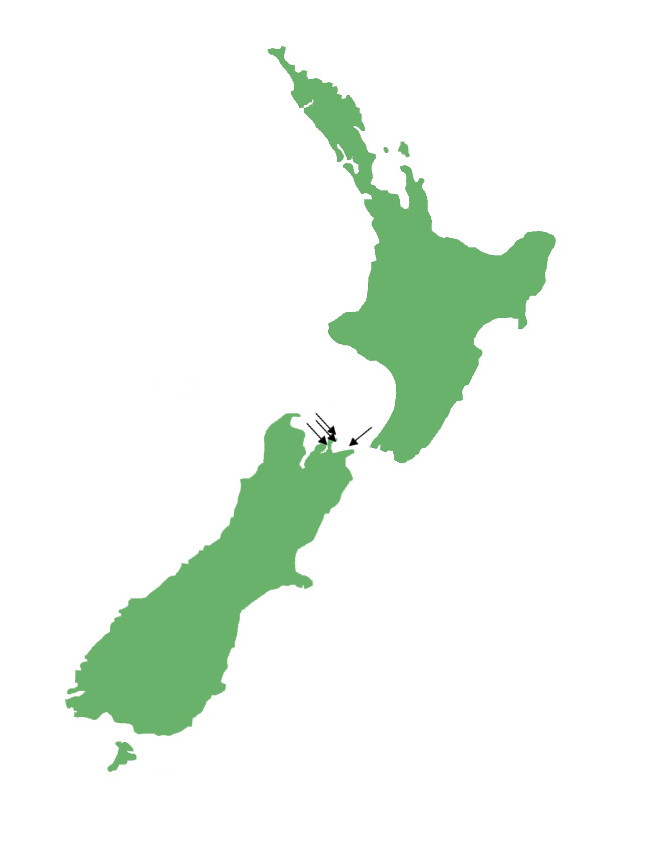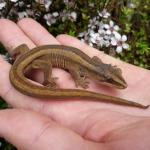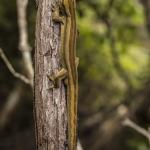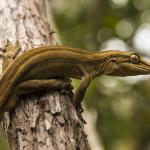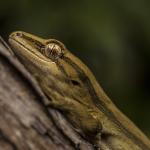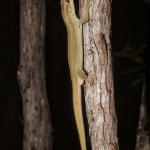- Home
- Herpetofauna Index
- Native
- Toropuku Stephensi
Toropuku stephensi
Southern striped gecko
Toropuku stephensi
(Robb, 1980)
Length: SVL up to 85mm, with the tail being equal to or longer than the body length
Weight: up to 13.85 grams
Description
A beautiful gecko with a unique pattern of stripes restricted to several islands in the Marlborough Sounds.
This species, as with other Toropuku, is characterised by their light to dark tan dorsal (upper) surfaces, which are bisected by wide pale stripes (white through to light brown/tan) running down either side of the spine. These stripes may be clean-edged or indented by mid-dorsal chevron patterning and converge to a single line along the tail. The lateral surfaces (sides) can vary widely from tan-coloured to vibrant tones of red, coral-pink or yellow. A dark brown canthal stripe (stripe between the nostril and eye) is present and joins the dark band underlining the pale dorsal stripes. A second dark brown stripe runs diagonally between the lower eye and the earhole. Ventral (lower) surfaces range from off-white to light brown and are often streaked in appearance, with fine dark flecks or spots. Their eyes are grey but may appear brown due to the intense vein-like patterning around the pupil. The mouth and tongue colour are pink, although the tip of the tongue may be darker in pigment, and the edges of the mouth may have an orange tinge. The toes are gracile in appearance.
Striped geckos can be distinguished from the co-occurring Woodworthia and forest geckos (Mokopirirakau granulatus) by their colouration, and striking striped patterning. Some co-occurring Woodworthia species have stripes, but they are not continuous from the nostril to the tip of the tail.
Southern striped geckos appear to have proportionally shorter tails and snouts than the northern striped gecko (T. inexpectatus). Southern striped geckos usually have a 'V' pattern between the eyes, compared crescents '()' in northern striped geckos, although abberant individuals with crescent markings have been found in the Queen Charlotte Sound population (Nick Harker personal communication, December 17, 2020).
Life expectancy
A minimum age of 16 years was recorded for one wild individual, with a minimum of 10 years recorded for a captive individual.
Distribution
Takapourewa / Stephens Island and Te Pākeka / Maud Island in the Marlborough Sounds. Translocated from Maud island to another island in the Pelorus Sound during 2019. A third remnant population was discovered in the Queen Charlotte sound during DOC lizard surveys in 2020.
Ecology and habitat
Arboreal and nocturnal. Striped geckos inhabit forest and scrub habitats. On Maud Island, the species occurs in a remnant Kokekohe (Dysoxylum spectabile) forest but is most commonly encountered in patches of NZ flax (Phormium tenax) and bracken fern (Pteridium esculentum) where they can form dense populations of over ~200 per hectare (Nick Harker personal communication, March 3, 2019).
Southern striped geckos are nocturnal. On Maud Island, they are most readily encountered on warm, humid nights either during or just after light precipitation.
Social structure
Striped geckos are elusive, with their social structure and behaviour largely unknown. They are thought to be largely solitary, although can form dense colonies in flax or bracken fern.
Captive northern striped gecko (T. inexpectatus) do not show the same level of territorial fighting as other species of gecko, with two males able to coexist in the same enclosure with no aggressive behaviour and only one case of behavioural suppression in a juvenile female (D.R.H. Ashby, personal communication, October 11, 2016). Females will sunbathe in close proximity to each other.
Breeding biology
Like all of Aotearoa's gecko species, the southern striped gecko is viviparous, giving birth to one or two live young biennially (once every two years) around late summer/early autumn. As is the case with many lizard species, mating in Toropuku may seem rather violent with the male repeatedly biting the female around the neck and head area. Sexual maturity is likely reached between 1.5 to 2 years.
Diet
Southern striped geckos are omnivores. They are primarily insectivorous in nature, but are also thought to feed on the nectar, and small fruits of several plant species, and the honeydew of scale insects when they are seasonally available. Having both arboreal and terrestrial tendencies, this species utilises the food sources in both habitats, preying on a mix of flying (moths, flies, beetles) and terrestrial invertebrates (wēta, grasshoppers, beetles, etc.).
In captivity, a close relative - the northern striped gecko (T. inexpectatus) - has been observed actively hunting, although, shows more caution and stealth than other native species such as Duvaucel’s gecko (Hoplodactylus duvaucelii) and green geckos (Naultinus spp.) (D.R.H. Ashby, personal communication, September 20, 2016). In captivity northern striped gecko feed on a wide range of winged insects, including lacewings and dobsonfly, as well as fruit.
Disease
The diseases and parasites of Aotearoa's reptile fauna have been left largely undocumented, and as such, it is hard to give a precise determination of the full spectrum of these for many species.
The southern striped gecko, as with many of our other gecko species, are a host for at least one species of endoparasitic nematode in the Skrjabinodon genus (Skrjabinodon poicilandri), as well as at least one strain of Salmonella. In addition to this, they are likely to be a host for at least one species of ectoparasitic mite.
Wild Toropuku have been found with Disecdysis (shedding issues).
Conservation status
DOC classify Toropuku stephensi as 'nationally vulnerable'.
A conservation translocation of southern striped geckos was undertaken in February 2018 whereby 100 striped geckos were caught on Te Pākeka / Maud Island and released onto another island nearby, to establish an additional population of this threatened species.
Interesting notes
The southern striped gecko gets both its common and specific name (stephensi) from Takapourewa - Stephen’s Island, where the species was first discovered.
A second population was discovered by members of the forest and bird protection society on Te Pākeka / Maud Island in 1989.
A third remnant population was discovered in Queen Charlotte Sound during DOC lizard surveys in 2020 (Nick Harker personal communication, January 2020). Given the geographic separation of this population from those in Pelorus Sound, it is possible there may be remnant populations at other sites (on islands or the mainland), which have remained undetected.
The genus Toropuku (striped geckos) sits within the "narrow-toed" clade of New Zealand's gecko fauna. This clade includes all genera apart from Hoplodactylus and Woodworthia. Of these "narrow-toed geckos" Toropuku is most closely related to Naultinus (green geckos) being their sister clade.
References
Gill, B.J., & Whitaker, A.H. (2007). New Zealand frogs and reptiles. Auckland: David Bateman Limited.
Hitchmough, R.A., Barr, B., Lettink, M., Monks, J., Reardon, J., Tocher, M., van Winkel, D., Rolfe, J. (2016). Conservation status of New Zealand reptiles, 2015; New Zealand threat classification series 17. Wellington: New Zealand Department of Conservation.
Jewell, T. (2011). A photographic guide to reptiles and amphibians of New Zealand. Auckland: New Holland Publishers.
Robb, J. (1980). New Zealand amphibians and reptiles in colour. Auckland: Collins.
van Winkel, D., Baling, M. & Hitchmough, R. (2018). Reptiles and Amphibians of New Zealand: A field guide. Auckland: Auckland University Press, 376 pp.
Whitaker, A.H. (1991). Research on the striped gecko (Hoplodactylus stephensi), on Maud Island Pelorus Sound, Marlborough, 6-12 March 1991. Contract Report No. 1094.
Southern striped gecko in fernland habitat (Te Pākeka / Maud Island). © Nick Harker
